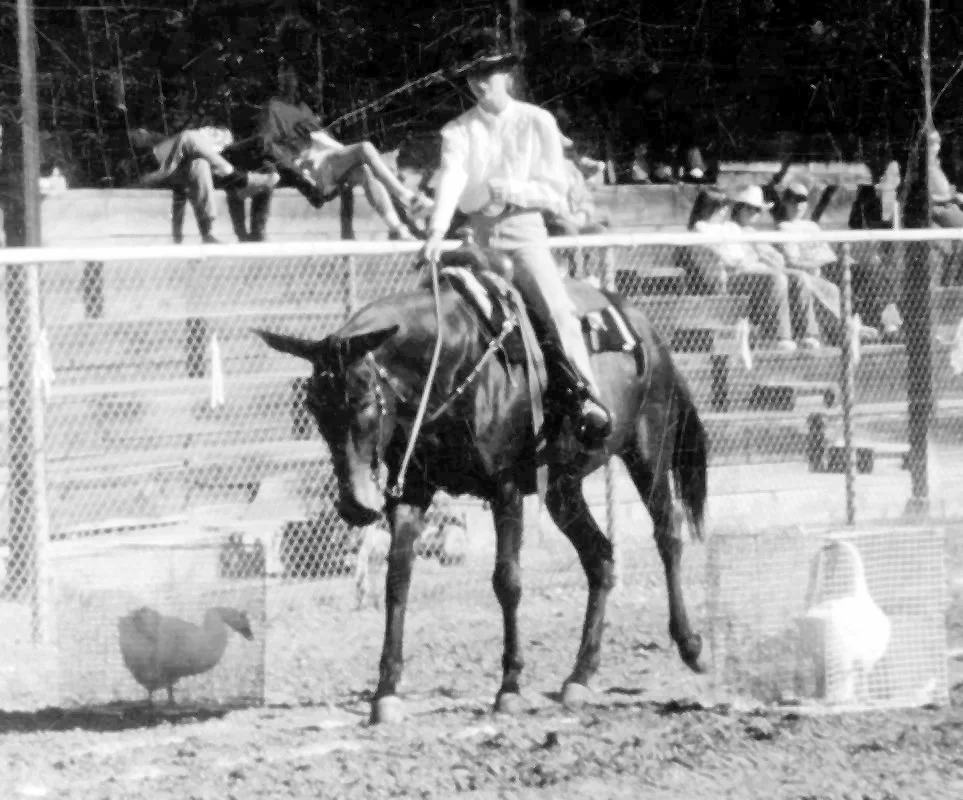Are You Listening To Your Mule?
by Susan Dudasik
This article was reprinted from the May 2005 issue of Mules and More. Author Susan Dudasik was a long-time contributor to Mules and More, and has since developed the “Misfit Farm’s Trail Equine Level of Excellence Program, a progressive self-guided certificate program for riders to help create a safe and sane equine both in the arena and on the trails. There are three levels of ridden and groundwork requirements. “The goal for this program is for folks to have fun spending time with their equine and try new challenges,” said Susan. To find more information on this innovative program, visit www.facebook.com/Misfitfarmtrailprogram
A good mule and rider team is based on trust, respect, and good communications, but are you the partner doing all the talking? Granted, mules can’t talk, but they can speak volumes through their body language. You just need to be willing to listen.
Recently, when riding with a friend, my mule started to slow down. Her ears kept swiveling backward and she was trying to turn her head. Without really thinking, I turned around and saw two riders and a dog behind us. I reached down, patted her neck and whispered, “It’s OK, I see them.” My mule relaxed and went back to her regular walk.
Meanwhile, my friend’s mule was doing about the same thing but my friend, instead of listening to her mule, started complaining he was lazy and gave him a hard kick. As we continued, the mule got worse. “I don’t understand what’s wrong with him,” complained my friend. It finally dawned on me what the mule’s problem was. I told her there were riders behind us and suggested she turn her mule around so he could see them. Once she did that he was content.
Notice this mules ears, she’s not really sure walking between two cages of live geese is a smart thing to do, but because her rider is confident, the mule is willing to try
Through the years I’ve learned to read the subtle signals my mule sends; the twitch of an ear, a quick turn of the head, or a slowing of her gait. Usually when she does any of these things, if I take a second to look around, I’ll see what she’s seen, heard or smelled. Often I’ve been rewarded with a special treat....a herd of antelope, a doe and fawn, or a pheasant. Other times she’s alerted me of possible dangers, rattlesnakes and skunks hiding in the brush, and dogs or riders coming up behind us. I’ve learned to trust her instincts and, on those rare occasions, when she’s really insistent about not going near something on the trail, I’ll give her the benefit of the doubt and go around.
Watch your mules’ ears, they speak volumes. Though this team can’t actually see what their driver is doing, they are very aware of him
Often, especially when on the trail, a mule will plant his hooves, tense up and stare into the distance. When this happens, the first thing many riders do is shorten the reins and kick the mule. Still in a tense alert mode, the mule either starts prancing or goes a few steps and stops again. This causes the rider to either tense up, fearing the mule will run off, or kick him harder to make him go. Either way, the rider is telling the mule there is something to be afraid of.
Learning to read your mules’ signals takes practice. The first thing to watch is his ears, they’ll tell you what direction to look. If he suddenly starts holding his ears back, take a quick look behind you. If his ears are pricked tensely forward, scan what’s in front of you. Maybe there’s an odd shaped rock, or a deer in the trees. If one ear swivels to the side, look that way. Equine ears are great radars and can pick out all kinds of interesting things; you just need to pay attention to them.
The next time your mule starts to focus intently on something, instead of getting after him, take a second to look for what’s bothering him. Often if you reach down and simply put your hand on his neck he’ll relax a bit. If he’s really tense, try rubbing his neck just in front of the saddle and speaking reassuringly to him. As a person who believes in talking to my mule, I’ll say something like, “it’s OK,” or “silly girl, it’s just a rock.” When I do this, it causes me to relax and stop holding my breath. In return my mule usually responds with a big sigh before she, too, relaxes.
It’s obvious from his body language that this horses’ attention is not on what the rider is doing, and if the rider fails to acknowledge this message, she could be in big trouble
At this point, I’m sure many readers are thinking I allow my mule to stop and look at something whenever she feels like it. On the contrary, my mule rarely stops because I can usually acknowledge her concerns before she has to go that far to get my attention. We have an active partnership. I try to be aware of her body language the entire time I’m with her. Often riders become so involved in what they’re doing, they forget to listen to their mules. Mules are flight animals that depend on their keen sense of smell and hearing for survival. As riders, we can prevent many undesirable ‘behavior’ problems if we’d learn to listen to our mules before reacting.



